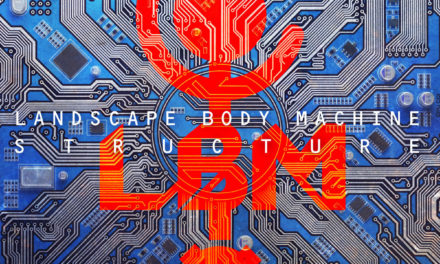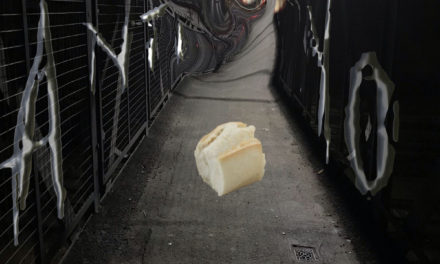In Conversation is a feature in which the senior staff talk about a record we’ve been listening to, recent or otherwise. It’s a nice informal (and often rambling) way we sometimes like to approach an album we have a lot to say about, like the funked-out third LP from Los Angeles’ High-Functioning Flesh…
High-Functioning Flesh
Culture Cut
Dais Records
Bruce: Now three albums in, Gregory Vand and Susan Subtract’s work as High-Functioning Flesh has not only established its own territory, but seems to be operating almost entirely independently. The combination of sloping funk and rubbery beats which make up Culture Cut really don’t suggest any band to me other than HFF themselves. That could just be a function of me getting more familiar with the things that make the band’s songs tick; it was tempting and fun to wax postulative about influences, especially knowing what we do about Vand and Subtract’s deep knowledge of various arcane musical histories and sub-genres. But after playing Definite Structures pretty much non-stop in 2015 (and 2016), in approaching Culture Cut I was struck by how the band had honed in on all of the things which seemed to make them stand out from their peers (and their influences), and had cut out anything which didn’t seem to fit the HFF ethos as they’d established it. Does that scan with your first passes at the record at all?
Alex: I went back and spent some time with their debut LP A Unity Of Miseries, A Misery Of Unities before really digging into Culture Cut, for the simple reason that I have listened to Definite Structures so much that I needed an actual refresher to really position the new record mentally with the previous ones. In doing so I think it really threw what you’re talking about into sharp relief; this is the record you get from a band who have figured out exactly how they want to sound and are exploring what they can do within that. I’d never damn the album with a backhanded assessment like “If you liked the last record, this is more of the same”, but in considering High-Functioning Flesh from the original cassette demo to present this is less of a jump in terms of mood and presentation and much more of a refinement. Which is a pretty long-winded way of saying yeah, this is a band who have it dialed in.
Okay, so here’s a thought I had during a late night listening session: how much of what High-Functioning Flesh accomplish on this LP is based on the idea of engaging the listener physically? Without getting into a broader discussion of body music, I’m wondering about how the rhythms, tempos and structures of this record are meant to elicit movement and an actual material response on the part of the audience. Even beyond the baseline level that all beat-driven music can invoke dancing, moshing, or whatever, I feel like HFF are exploring how to cut through how we consciously process their music and tap into something a lot more deeply-rooted in our nervous system. Like the breathing at the end of “Drawn Out” is a marker for that idea, a literal suggestion of the exertion of performer and audience.
Bruce: I was listening to the record at the gym earlier today and actually found myself syncing my own reps and breathing with “Drawn Out”, no foolin’! Hell, if nothing else looks at the band name. There are a lot of purposes to which the functioning of our bodies could be lent – dance, sex, violence, athletics – and the oblique way in which HFF’s lyrics refer to impulses, frustrations, and desire means they could all be on the table. But yes, between Susan’s constant grunts and gasps and all of the little synth flourishes it doesn’t just feel like music to move to but music about movement.
I guess that’s as good a connection as any to talk about how underscored the funk element of HFF’s delivery feels in this record. It’s always been a big part of the band’s sound, but right from the get go in the way that a funky rhythm’s pulled out from the stuttering sample of “Talk About”, there seems to be a real focus on rhythmic engagement rather than rhythmic aggression…which is a bit of reductive way to look at the funk/EBM nexus, I admit. However, without changing their thematics around that much the duo really seem to be doubling down on sounds which feel, if not softer, more rounded around the edges and can produce a more groove-based feel. I know we talked along these lines at least in terms of the band’s philosophy when Definite Structures came out, but it really feels like something that’s come into its own musically here. I guess that’s another thing that they’ve dialed in, as we were talking about before.
Alex: Yeah, this is the band at their absolute funkiest. I’m super into how songs like “Gone Home” articulate that; the laidback vocal performance from Susan and the chattering synthline and vocal sample that just bubbles away behind the bassline give it this loose, groovy feel that I don’t think you would have heard from the band at their inception. I love how “Invoking Phantoms”, which follows it directly, kind of reinvents that groove as a vehicle for a very clean and melodic vocal turn and a real singalong chorus of the kind that the band hasn’t really done before. In a lot of ways these tracks are differentiated by the way they apply rhythm, more than things like instrumentation.
Which leads me to another thing I wanted to discuss, namely that this album sticks to a very specific set of sounds pretty much throughout. Not that they’re reusing the same drum sounds or synths on every song, but there isn’t a vast variety in how those component parts are presented across the record. That limited palette really makes you focus on the differences in structure and construction. A song like “Provoke the Wound” is on paper very similar to “Gone Home” but they’re actually very different in practice. All the variety comes from things like how Susan rides the beat as a singer, how the vocal cut ups play against the drums and how those leads swoop in. Speaking of those leads, do you get a jazzy, live feeling from how they’re played? So many of the songs feature prominent melodic parts that don’t seem quantized or edited at all, which is pretty cool and different.
Bruce: I’m almost always terrible at guessing what’s programmed, what’s live, what’s quantized, and what isn’t, but yeah: this album sounds very much like their live sets, in particular the DB20 one we caught last year which was very heavy on new material. I’ve also seen them play three times (I think) between the release of Definite Structures and Culture Cut, so the idea of HFF as a live entity is definitely shaping how I’m approaching this record, and likely just about all of their material from this point forward. My point is that it’s very easy to visualize the pair of them playing this record pretty much as is in a live setting.
When we first got onside with HFF we were really interested in how people from outside familiar cliques and labels were approaching what then seemed like “roots” body music from a very different set of perspectives and scenes than had been common for years. That distinction’s definitely blurred since then (to everyone’s benefit, I’d say), but I like that Culture Cut seems to have set aside issues of lineage and influence, be they sonic or sub-cultural, and instead feels like Susan and Greg zeroing in on what they like about their own music, or at least what sounds or ideas get them up in the morning and into the studio. Final thoughts?
Alex: Albums like Culture Cut are a challenge to make. It’s predecessor felt totally revelatory, a reframing of familiar sounds in a modern context that also happened to be super well-written and compulsively listenable. How do you follow-up a record that done changed the game when you aren’t looking to reinvent yourself or your sound again?
The answer is you dig in hard and work to find new ways to explore your ideas within the rubric you’ve established. Culture Cut is an album made by a band who have themselves figured out, and are getting to enjoy the fruits of their labours by playing with the possibilities of their template. It’s not an album you could mistake for anyone else; this is High-Functioning Flesh, and that should serve to tell you what it sounds like better than any genre descriptor. Recommended.






